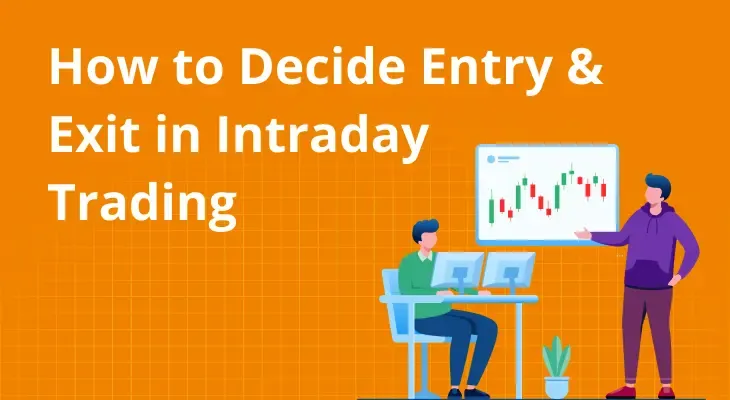
Table of content
How To Enter And Exit In Intraday Trading?
Intraday trading, also referred to as day trading, is a widely favoured trading method involving the buying and selling of financial instruments within the span of a single trading day. Mastering the art of how to decide entry and exit in intraday trading is essential for traders looking to capitalise on short-term price movements.
In this article, we will explore various strategies to help you make informed decisions on when and how to enter and exit in intraday trading. By mastering the art of decision-making in intraday trading, you can enhance your trading skills and increase your chances of success.
The Best Intraday Entry and Exit Strategies
Here are some proven strategies to help you make informed decisions and become a proficient intraday trader:
1. Entering Trades Based On Market Trends
When it comes to intraday trading, one of the most critical factors to consider is market trends. Understanding how to decide entry and exit in intraday trading begins with identifying the prevailing trends in the market. Use technical indicators such as Moving Averages, Relative Strength Index (RSI), and Moving Average Convergence Divergence (MACD) to determine whether the market is experiencing an uptrend, downtrend, or moving sideways. By entering trades that align with the trend, you can maximise your potential for profitable outcomes.
2. Deciding The Entry Right Price
Choosing the right entry price is crucial in intraday trading. Buying at the right price can provide a buffer against potential losses. Utilise technical analysis tools like Support and Resistance levels, Fibonacci retracements, and candlestick patterns to pinpoint optimal entry points. Avoid entering trades at extreme price levels or when there is uncertainty in the market, as this could expose you to higher risks. Remember, patience and precision in identifying entry points are key to successful intraday trading.
To further enhance your entry points, consider using multiple indicators to confirm the trade. For example, if a stock is showing an oversold condition on the RSI indicator and is bouncing off a significant support level, it can be an excellent entry opportunity. Combining indicators can increase the reliability of your trade setups.3. Enter With A Fixed Stop Loss And Exit At Stop Loss
To make sound decisions on when and how to enter in intraday trading, consider using multiple indicators and conducting a thorough analysis. Controlling risk is paramount in intraday trading. Determine a fixed Stop Loss level for each trade to limit potential losses. It is essential to exit the trade once the Stop Loss is triggered, as emotions should not influence intraday trading decisions. Adhering to this rule helps you maintain discipline and protect your capital, preventing significant drawdowns that could affect your overall trading performance.
To set an appropriate Stop Loss, consider the volatility of the stock and its average price movements. A common practice is to set the Stop Loss just below the support level for long trades and just above the resistance level for short trades. Remember, the Stop Loss is not a price point where you expect the stock to reverse; it is a safety net to protect your capital in case the trade doesn't go as planned.4. Set Viable And Reasonable Targets
Having a clear profit target is vital in intraday trading. Before entering a trade, establish a realistic profit target based on technical analysis and market conditions. Avoid setting arbitrary profit targets driven by greed or fear. Setting viable and reasonable targets increases the likelihood of achieving them and provides a clear exit signal when the trade turns in your favour. Remember, consistency in achieving profit targets can lead to long-term trading success.
termine profit targets, use technical indicators to identify areas of potential resistance or support. For instance, if the stock has historically reversed its trend near a specific price level, consider setting your profit target just below that level for long trades and just above it for short trades. Additionally, consider using trailing stops to lock in profits as the stock moves in your favour.5. Buy Strong Stocks Going Up
Intraday traders often focus on momentum trading, which involves buying stocks that are trending upward with significant volume. Identify strong stocks with positive news, solid fundamentals, and a history of consistent price appreciation. Utilise technical indicators like the Relative Strength Index (RSI) and Moving Average Convergence Divergence (MACD) to confirm the stock's strength before entering a trade. A combination of fundamental and technical analysis helps you identify strong stocks and capitalise on potential price movements.
entify strong stocks, look for companies with robust financial performance, positive earnings growth, and a competitive advantage in their industry. Additionally, consider using sector analysis to focus on industries that are performing well in the current market conditions.6. Sell Weak Stocks Going Down
Similar to buying strong stocks, selling weak stocks that are trending downward can be profitable in intraday trading. Look for stocks with negative news, weak fundamentals, or a lack of buying interest. Technical indicators can also assist in identifying selling opportunities. Selling weak stocks allows you to benefit from downward price movements, making it an effective strategy to profit in a bearish market environment.
To identify weak stocks, focus on companies with poor financial performance, declining earnings, or negative sentiment from market participants. Additionally, consider using bearish technical patterns like Head and Shoulders, Double Tops, or Bearish Engulfing patterns to confirm selling opportunities.7. Do Not Enter When Markets Are Choppy
Intraday trading in choppy or volatile markets can be risky. Uncertain market conditions can lead to sudden price swings and unpredictable outcomes, making it challenging to implement a consistent trading strategy. Wait for clear trends to emerge and avoid trading during major economic announcements or when there is significant uncertainty in the market. Being patient and selective in entering trades during stable market conditions can help improve your trading success rate.
During choppy market conditions, consider shifting your focus to other forms of trading or take a break from trading altogether. Swing trading or position trading may be more suitable during such periods, as they allow you to hold positions for a longer duration, mitigating the impact of short-term market fluctuations.
Conclusion
Intraday trading can be an exciting and rewarding endeavour, but it requires a well-defined strategy for entering and exiting trades. By following the best entry and exit strategies, you can improve your chances of success in this fast-paced trading environment. Remember always to stay disciplined, manage risk effectively, and never let emotions cloud your judgement. With practice, perseverance, and continuous learning, you can become a proficient intraday trader and navigate the dynamic Indian stock markets with confidence.
FAQ
How much capital do I need for intraday trading?
The capital requirement for intraday trading varies based on individual risk appetite and trading style. It is advisable to start with capital that you can afford to lose and gradually increase it as you gain experience. Remember, risk management is crucial in preserving your capital and long-term trading success.
Can I use leverage in intraday trading?
Yes, most brokers offer leverage to intraday traders, allowing them to trade with a larger position than their account balance. However, using leverage amplifies both profits and losses, so exercise caution and understand the risks involved. Remember, leverage can lead to significant gains, but it can also result in substantial losses if not managed carefully.
How can I improve my intraday trading skills?
Continuous learning is essential for improving your intraday trading skills. Stay updated with market news, study technical analysis, and practice trading using demo accounts before risking real money. Additionally, consider joining trading communities and seeking guidance from experienced traders. Remember, learning from both successes and mistakes is crucial for honing your trading abilities. Engaging in market research and staying updated with economic events can also enhance your trading knowledge.
What are the best times to trade in the intraday market?
The intraday market has specific hours of high volatility and liquidity, making it more favourable for trading. The best times to trade are typically during the opening and closing hours of the market, known as the "first hour" and the "last hour." During these times, there is increased trading activity and price movements, providing ample opportunities for intraday traders to execute their strategies.


